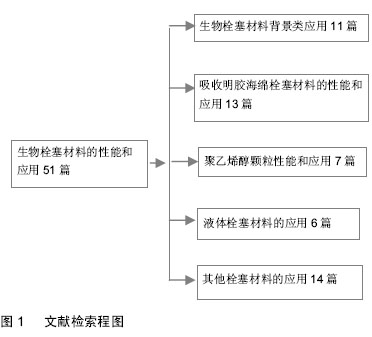
2.1 纳入资料基本概况 纳入的文献包括生物栓塞材料的背景类文章11篇
[1-11],可吸收明胶海绵栓塞材料的性能和应用的文章13篇
[12-24],聚乙烯醇颗粒性能和应用文章7篇
[25-31],液体栓塞材料的应用6 篇
[32-37],其他栓塞材料的应用14篇
[38-51],以此为依据对各类生物栓塞材料的特性和修复血管的效果进行了归纳和总结。见
图1。
2.2 纳入资料的研究结果特征
2.2.1 可吸收性栓塞材料明胶海绵 明胶海绵是在体内可降解的中期栓塞材料,既是一种胶原蛋白,又是一种高分子生物材料[12]。明胶海绵是明胶液经发泡、固化、冻干和灭菌而制成的一种海绵状固体制剂,由于具有良好的组织相容性、血液相容性、生物可降解性、弱抗原性和生物安全性要求,使得它成为优越的栓塞材料[13]。可根据靶血管的大小剪成小块,小条或1.0-2.0 mm颗粒装入2-5 mL注射器中,其特点是可压缩性强,有再膨胀性,无毒无抗原,价格低廉,制备简单,易于注射,栓塞可靠,一般1-3周吸收。
胶原蛋白是动物体内含量最丰富、分布最广泛的蛋白质。胶原蛋白具有独特的三螺旋结构、低抗原性、无毒性、良好的生物相容性和生物可降解性等特点[14-15]。氧化纤维素的作用类似于明胶海绵[16]。目前,中国使用的胶原蛋白主要来自猪和牛的皮肤和跟腱,从林蛙残体制备明胶海绵可促进林蛙综合利用,提高林蛙附加 值[17-18]。鱼鳞和鱼皮等水产品废弃物约有40多万吨,这些水产品废弃物均含有丰富的胶原蛋白,其氨基酸组成与陆生哺乳动物胶原蛋白无显著差异,且其不存在人畜共患的传染性疾病,具有极大的开发和利用价值,开发鱼皮等水产品废弃物的利用新途径,不仅可提高水产品加工的附加值,而且能减少环境污染,具有良好的经济和社会效益。
明胶海绵使用前先进行血管造影,以了解病灶的供血动脉及插管途径有无相关的侧支循环[19]。按照标准技术进行超选择插管,插入导管的位置应尽可能接近治疗部位,要防止对正常血管的栓塞[20]。根据病灶的情况选择大小适宜的颗粒,颗粒大小选择不当,可能导致颗粒进入正常组织的供血动脉或进入病灶流出的静脉[21]。用适量低浓度对比剂(通常用30%-40%)离子型如泛影葡胺或非离子型如碘普罗胺、三碘三酰胺六醇苯与明胶海绵颗粒混合,使成均匀的混悬液并浓度适当,不得有泡沫存在。将混悬液吸入注射器,并且浓度适当,颗粒混悬良好,若混悬液太浓,则可以堵塞导管,应设法避免。在血管造影机透视下,将明胶海绵颗粒混悬液通过导管注入,注入速度适当,不得返流,否则有可能进入非栓塞动脉,引起异位栓塞,从而导致组织器官坏死。连续注入明胶海绵颗粒,直到观察结果满意。
明胶海绵是目前应用最多的栓塞材料之一,因安全、无毒性、取材容易、使用方便而适用于各类出血性肿瘤、某些血管畸形的栓塞治疗[22]。然而,作为生物医用材料,水产胶原与陆生哺乳动物胶原存在共同的缺点,如体内降解快,柔韧性差等,限制了其应用[23]。此外,用戊二醛作为交联剂,也可以增加胶原蛋白医用材料的机械强度并减慢其体内的降解速率。并将壳聚糖加入明胶中制成一种同时能止血,促进肉芽组织生长,加快伤口愈合,既能外用又能内用的海绵制剂。但它自身也有缺点,它是非永久性闭塞,一般在血管栓塞后的第14-19天就开始吸收,3个月后可能完全被吸收,容易形成再通。另外,当超选择插管困难的情况、动脉太小颗粒不易进入的情况、当动静脉瘘比颗粒大的情况、需要永久性栓塞的患者等情况下不宜使用明胶海绵[24]。
2.2.2 聚乙烯醇颗粒 聚乙烯醇颗粒是一种永久性栓塞剂,是一种高分子材料,为白色或微黄色质轻而软的多孔海绵颗粒状物、多孔的不规则粒子,原材料为聚乙烯醇,须与对比剂混合后方能显影[25]。使用时需将聚乙烯醇切成碎片,以对比剂浸泡,适用于大中血管的栓塞,粉末状用于末梢血管栓塞,无毒,不溶于水,组织相容性好,膨胀系数高,纤维组织可很快长入其中,注入血管系统后,对血管进行机械性堵塞。根据颗粒直径大小分为不同规格聚乙烯醇泡沫栓塞微粒被设计用于血管栓塞血管丰富的肿瘤以及动静脉畸形的血管内栓塞[26-27]。
聚乙烯醇颗粒用于肿瘤的供养动脉或畸形血管的血管栓塞,利用聚乙烯醇注入人体,机械栓塞病变部位血管,在聚乙烯醇颗粒间隙中血栓物质、机化,使血管永久栓塞,四五个月后,血管内膜、中膜与外膜仍是完整的。聚乙烯醇颗粒注入人体后是机械栓塞血管起治疗作用,它本身不具任何药理作用。不溶于水与乙醇,可溶于甲酸生物性能,具有良好的生物安全性,机械式栓塞血管,无致敏反应,无全身急性毒性,无皮内刺激反应,使用安全、有效[28]。
使用前先进行血管造影,以了解病灶的供血动脉和插管途径及相关的侧支循环[29]。按照标准技术进行超选择插管,插入导管的位置应尽可能接近治疗部位,要防止对正常血管的栓塞[30]。根据病灶的情况选择大小适宜的聚乙烯醇颗粒,颗粒大小选择不当,可能导致颗粒进入正常组织的供血功脉或进入病灶流出的静脉[31]。
2.2.3 液体栓塞材料 液体栓塞材料是较为理想的栓塞材料,液体栓塞材料一般分为黏附性液体栓塞材料和非黏附性液体栓塞材料两种[32-33]。已经用于实验和临床的非黏附性液体栓塞材料主要有无水乙醇、碘化油、聚醋酸乙烯酯乳液及藻酸盐液体栓塞材料等[34-35]。无水乙醇具有强烈的蛋白凝固作用,造成靶血管内皮细胞和肌组织坏死,血液有形成分蛋白凝固和细胞崩解成泥状淤塞毛细血管并继发局广泛血管内血栓形成,造成靶器官缺血坏死,其栓塞能力与到达靶血管的瞬间浓度有关。但透视下难以跟踪,注射速度难掌握。单纯碘化油对正常血管栓塞作用不大,对特定的病理性血管有亲和力,加温至100-120 ℃可造成局部广泛性血管栓塞,但由于非黏附性液体栓塞材料使用的有机溶剂二甲基亚砜具有潜在的血管毒性,影响了非黏附性液体栓塞材料的应用。黏附性液体栓塞材料不具有血管毒性,得到了广泛的应用。
临床应用的黏附性液体栓塞材料主要是氰基丙烯酸正丁酯,氰基丙烯酸正丁酯在体积分数5%的葡萄糖溶液中不容易发生聚合,能够方便地将液体氰基丙烯酸正丁酯注入到血管内[36]。但是,氰基丙烯酸正丁酯黏附性较强,容易发生“黏管”问题,即微导管黏附在血管壁上,影响治疗效果,并具有一定的危险性,且在栓塞过程中容易导致导管黏连,导致并发症[37]。另外,以氰基丙烯酸正丁酯为主要成分的栓塞材料在将动脉瘤完全栓塞时造成了巨大的占位效应;并且,在治疗之后的生活和工作中,由于栓塞材料的密度较大,聚合物栓塞的动脉瘤随着运动产生的惯性会造成病患极大的不适。
2.2.4 其他栓塞材料 弹簧圈具有良好的顺应性,栓塞定位准确,可以充分填塞球囊到达不了的间隙及较小的瘘口,能通过较细的导管完成较大直径的血管栓塞[38]。同时,弹簧圈在操作过程中安全性较高,不会造成血管内膜的损伤且具有较好的可控性、随意性、永久性栓塞,可随动脉瘤大小、形态成形,可以根据瘘口的大小选择不同的型号的弹簧圈[39]。栓塞时将弹簧圈置入动脉瘤内促使瘤内血栓形成,甚至在弹簧圈位置放置不当的情况下回收并重新放置,能由X射线平片长期随访观察[40]。另外,应用弹簧圈栓塞瘘口时可以达到致密栓塞,降低复发率[41]。它的缺点就在于它栓塞不完全,属于近端栓塞材料,易建立侧支循环,在微导管中摩擦力大,生物相容性较差,弹簧圈的移位和正常血管的栓塞,因此并不是一种理想的栓塞材料[42]。
可脱性球囊位永久栓塞、定位精确,一般多用于隐匿性假性动脉瘤治疗时闭塞载瘤动脉。由于球囊的使用技术较为复杂,价格比较昂贵,只能使用1次,并且在使用球囊的过程中,有时会出现球囊在导管中行走困难,有时难以将部分充盈的球囊经动脉输送到瘘口当中的问题,所以现在很少用于瘤腔内栓塞[43]。另外,圆形球囊难以填塞不规则的瘤腔、球囊泄气、球囊撑破动脉瘤、充盈后因与骨折骨刺接触而发生破裂等也成为其在临床应用当中的致命缺点,所以现在已经较少应用于临床,最好和血管硬化剂或明胶海绵共同使用,以达到最佳的治疗效果[44-45]。
自体血凝块是短期栓塞物,经导管抽出血液 10-20 mL,置于消毒器皿内自凝或加入凝血酶 100-200 U,根据需要切成小条块混合于对比剂中注入,特点是便于制备,无菌无抗原,栓塞时间24-48 h,最多达2周,但松软易碎,不保持块状,仅用于外伤或溃疡出血。
白芨粉用中药白芨粉作栓塞材料,以前曾有文献报道,但未见产品,并没有广泛应用[46-47]。郑传胜等[48]从中药白芨茎块中提取有效成分,制备成白芨胶栓塞剂,研究中药白芨胶作为血管栓塞剂的有效性、安全性及相关特性。研究发现白芨胶具有良好的血液相容性和组织相容性,无致热原性及毒性作用,认为白芨胶具有良好的血管栓塞作用、载体特性和缓释特性,使用方便、安全,是一种较理想的末梢型血管栓塞材料。
2.2.5 生物栓塞材料的临床应用比较 有研究应用将聚乙烯醇颗粒注入到栓塞末梢支气管动脉,再用明胶海绵颗粒栓塞近端支气管动脉结果显示聚乙烯醇及明胶颗粒栓塞支气管动脉安全、有效[49]。也有研究发现,真丝线段、聚乙烯醇颗粒及明胶海绵颗粒均可作为脾栓塞治疗脾功能亢进的栓塞材料,3者近期临床疗效相近[50]。王启弘 等[51]比较了球囊、液体栓塞剂、血管内支架、微弹簧圈等栓塞材料的优点与不足,探讨了各自的适用范围。随着机械可脱式弹簧圈和电解式可脱微弹簧圈等可控性微弹簧圈技术的进展,栓塞动脉瘤几乎可以达到与手术夹闭相同的效果,但还是存在很多问题。血管组织工程化的微弹簧圈似乎是一种非常理想的材料,有必要进一步研究。以往研究也显示采用明胶海绵栓塞出血动脉,栓塞血管前行血管造影、找到责任血管,阻断动脉血流,血管内栓塞创伤小,应用生物材料介入栓塞提高了安全性。
